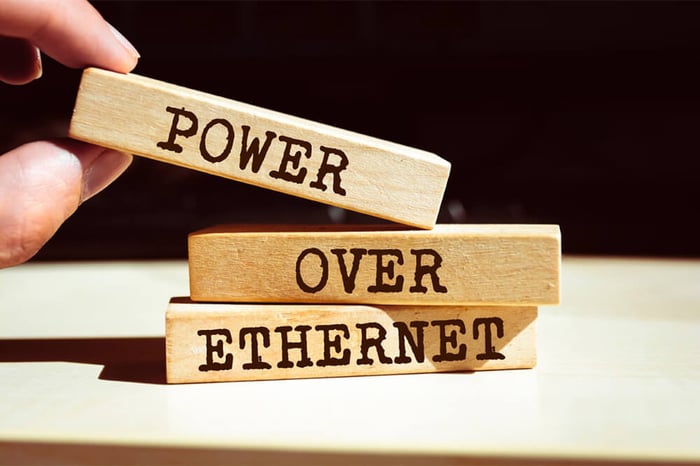You have no items in your shopping cart.

Power-over-Ethernet Switches 101: All you need to know
Power-over-Ethernet switches are essential for connecting different systems, users, and other resources in and outside the network. Here's a guide as to why.
As the technology evolved, the need for compact switching solutions offering multiple characteristics to support smooth communication and powerful performance also increased.
Traditional network/ethernet switches didn’t offer PoE capabilities inside a single appliance. But as the need came, companies started rolling out switches with data and power compatibility within a single compact yet powerful switching solution.
The Institute of Electrical & Electronics Engineers (IEEE) has categorized the PoE standard into several categories, as shown below.
|
SN |
PoE |
IEEE Standard |
Power |
|
1 |
PoE |
802.3af |
15.40W |
|
3 |
PoE+ |
802.3at |
30W |
|
3 |
4PPoE, Ultra PoE, PoE++ |
802.3bt Type 3 |
60W |
|
4 |
UPoE+ |
802.3bt Type 4 |
90W |
What is a Power-over-Ethernet PoE switch?
PoE or Power-over-Ethernet is a standard technology integrated with ethernet switches. These are specially designed to supply and transmit electric power and data over a single LAN or ethernet cable. The PoE technology allows the transmission of electrical power to end devices that require power to function, such as Wireless APs, IP phones, and IP cameras.
A PoE switch enables the transfer of power and data to edge devices using the same RJ45 network cable used in offices for LAN connectivity and communication. A PoE switch offers power to end devices where installation of an electrical source/outlet either doesn’t exist or is impossible. That is one of the primary benefits of having a power-over-ethernet switch in the network.
PoE technology makes deployment more convenient and cost-effective.
The power over ethernet capability allows businesses to eliminate the need for additional PoE injectors. This saves costs and the use of unnecessary devices for power supply. Before we had PoE technology integrated within the standard ethernet or gigabit switches, a typical design would look like something as shown below.

As seen above, a dedicated PoE injector supplies power to end devices like access points, cameras, and IP phones. The design involves additional and dedicated hardware to transmit electric power, which also increases the cost and number of devices in the LAN topology. Today’s switches are powered with PoE capability that enhances the network topology and eliminates the need for dedicated Power-over-Ethernet injector devices.
What benefits does the PoE switch serve to businesses?
Enterprises can enjoy vast benefits offered by PoE technology; this includes cost reduction, space and performance optimization, and network expansion, where power is the primary concern.
1. Reduces cabling
The foremost benefit of a power-over-ethernet switch is that it eliminates the extra cabling, effort, and ethernet or power cables required to run and operate the PoE-enabled devices. Additional cabling doesn’t only require effort, but it also makes the cabling unstructured and complex to organize when there is limited space in the network rack.
Assume that you have ten access points, 25 IP phones, and 10 IP cameras. Now calculate the power outlets or cables required at each device location. Apart from that, you would also need a cable manager and cable tagging to manage those cables. Now you can do the math.
2. Reduces Cost
PoE switches reduce the number of PoE injectors and power outlets required to support the power transfer to edge devices like AP, IP cameras, and IP phones. Therefore, they decrease the overall LAN infrastructure cost.

To supply power to twenty PoE edge devices, you need twenty dedicated PoE injectors and power outlets alongside the PoE injectors. A 24-port Gigabit PoE switch could simply replace this. The power-over-ethernet switch will also reduce human power and cabling costs drastically.
3. Eliminates unnecessary hardware
Performance optimization is a critical factor that impacts the overall IT infrastructure. One can boost the performance metric by reducing the unnecessary hardware devices placed between multiple nodes. Assume a power-over-ethernet injector or power source between a switch and AP or camera affects the performance and end-user experience. Removing it from the topology, enterprises can have a positive impact in terms of performance and compatibility.
4. Safeguards power-sensitive edge devices
Devices like AP, IP cameras, and IP phones are power-sensitive. They can be damaged due to insufficient power supply or power fluctuation at regular intervals. These devices are expensive and require a stable power source to run smoothly. The PoE technology minimizes the multiple points of failure by delivering the power and data using a single standard ethernet cable.
The PoE technology empowers organizations to safeguard these edge units with reliable power supplied over a single RJ45 ethernet cable. It ensures the edge devices receive the necessary power supply using reliable PoE technology.
An ideal Power-over-Ethernet switch should have the following elements:
1. Ability to control power in switch ports
A standard PoE switch empowers the administrators to manage and control the power that needs to be released from a PoE-enabled interface to edge devices. They can configure an interface or switch port to provide the desired power or limit it per the requirement. This feature becomes handy when edge devices are energy-sensitive. Due to excessive power supply, edge devices can crash, get damaged, or fail to operate.

The IEEE 802.3af PoE produces 15W of power, whereas 802.3at PoE+ delivers 30W of power. These two standards generally meet the power requirement of most wireless access points. The other two are ideal choices for IP phones and cameras.
Cisco, Juniper, and Aruba are a few top names that provide the ability to manage and control the power an interface can provide
2. Available in managed and unmanaged switching categories
The PoE switches are available in both managed and unmanaged switching platforms. Small enterprises that don’t necessarily need managed switches alongside PoE pay an extra amount without utilizing the services offered by managed switches. For example, a managed ethernet Power-over-Ethernet switch is of no use for home users with a flat network and coupe of APs.
The PoE-managed switches are compatible and functional for enterprises with medium to large networks. In contrast, unmanaged PoE switches are ideal for home users and small businesses.
3. Enable or disable PoE on interfaces
Most next-generation and advanced switching platforms offer the capability to enable and disable the PoE feature on an interface. Interfaces connected to end-host machines like computers, laptops, or printers don’t require PoE characteristics. Disabling PoE on unused interfaces is considered best practice and reduces unnecessary power drainage.
4. Multiple interface options
There are various types of businesses in the market; each is unique in its functionality and requirements. An Individual user can benefit from a Hub by extending their IT needs. In contrast, organizations require standalone, Stacked, or redundant switching technologies for backup and failures.

As seen in the market, the giant manufacturers of network switches like Cisco, Juniper, and Aruba are offering the Power-over-Ethernet switches in 8, 24, 28, and 48 port options. One can analyze their needs and can go for either of them.
When should you upgrade to a PoE switch?
Businesses typically decide when to upgrade to the PoE switch platform by looking at the number of PoE devices they have on the premises. A PoE injector will be the best solution if one has a single AP or camera. However, having an extensive infrastructure with a distributed network consisting of multiple PoE devices spread across the organization, the PoE switches are a more beneficial, flexible, and cost-effective solution.
The Power-over-Ethernet switches are an excellent fit for scalable networks and fast-growing organizations. It allows the future expansion and addition of new PoE devices when the business and users grow.

Before we jump to a conclusion, let’s have a look at some of the Pros and Cons of a PoE switch.
Pros:
● Offers flexibility and scalability
● Centralized control
● Minimizes multi-point failure
● IEEE-approved standard
● Available with multiple interface choices
● Available in managed and unmanaged switch variants
● Power delivery and distribution can be controlled on a per-interface basis
● Reduces additional hardware
● Eliminates the need for a dedicated PoE injector
● Minimizes the installation of dedicated power outlets
● PoE feature can be enabled or disabled on interfaces
Cons:
● PoE switches are expensive
● Central point of failure
● Due to centralized control, failure of the PoE switch can bring down the cameras, IP phones, and wireless access points.
● Limited up to 100 meters
Our thought
With greater flexibility and cost optimization, PoE technology embedded with an ethernet switch is an excellent way of scaling the network and power requirements. Furthermore, the PoE-managed switches can be used to define specific power per-interface basis, which means administrators can decide how much power to produce from which interface.
As industry experts in the networking industry, we recommend using PoE switches for scalability and ease of use. PoE switches are relatively simple to configure and deploy in the network. Unlike other network appliances, a PoE switch can be placed in a production network without impacting the running services. Cost reduction is another significant advantage of using PoE switches.
Want to know more about PoE switches and how they can help you boost network performance? How do they offer scalability and the flexibility to expand your network? CONTACT US now for detailed analysis and suggestions from industry experts.













